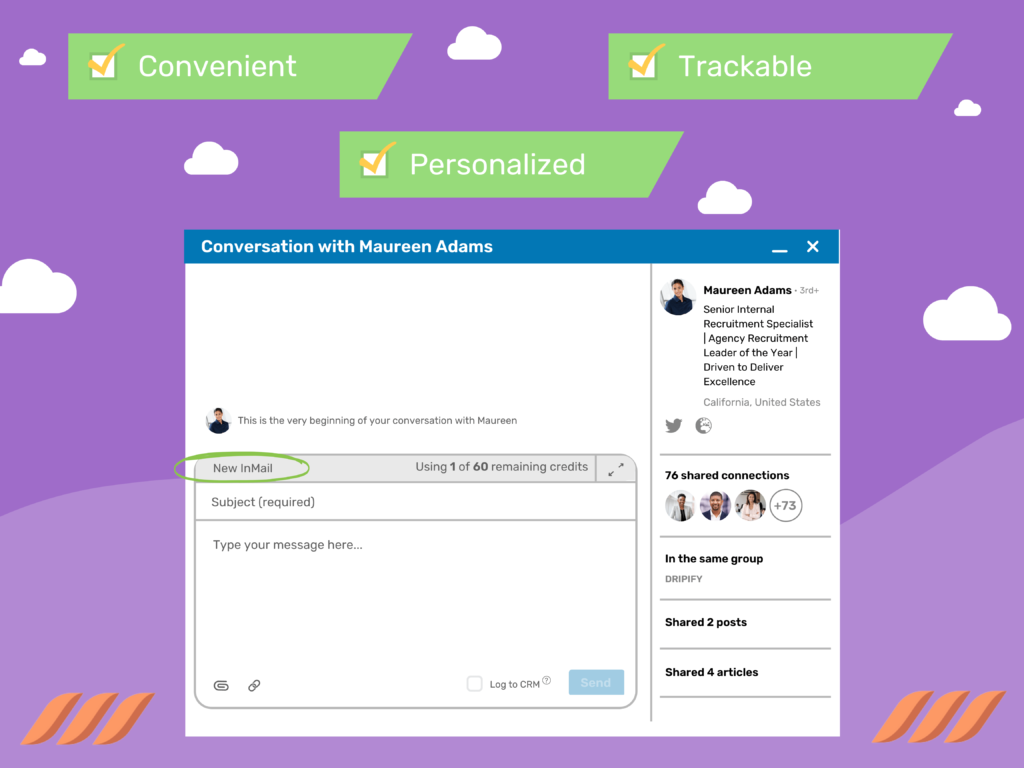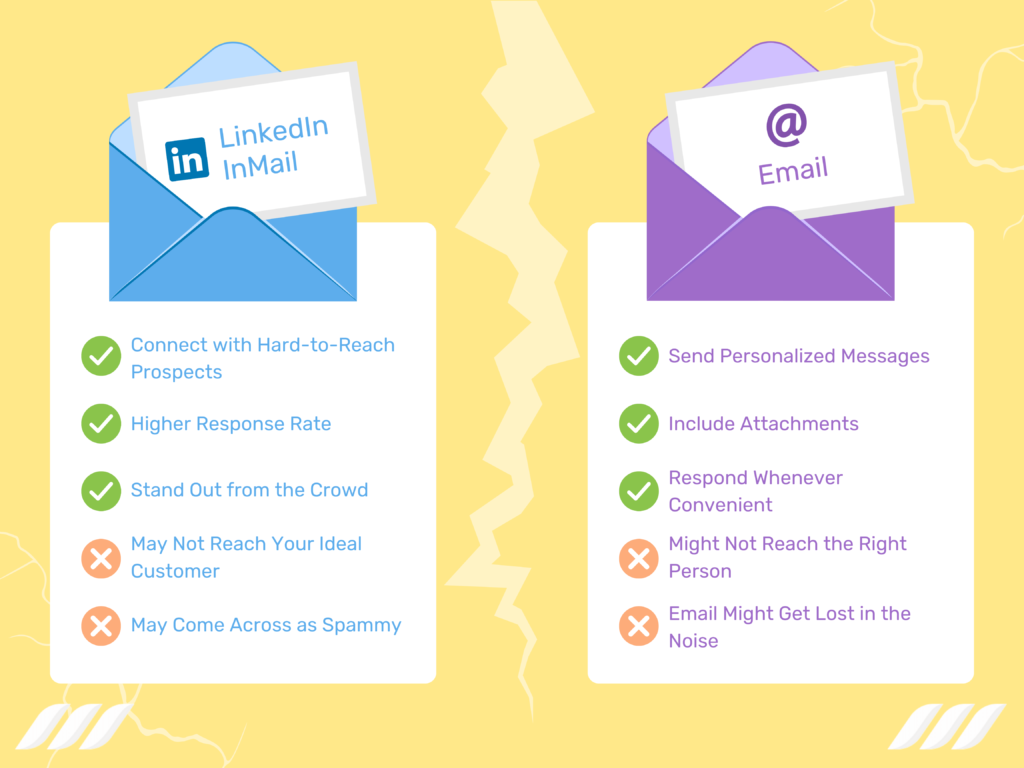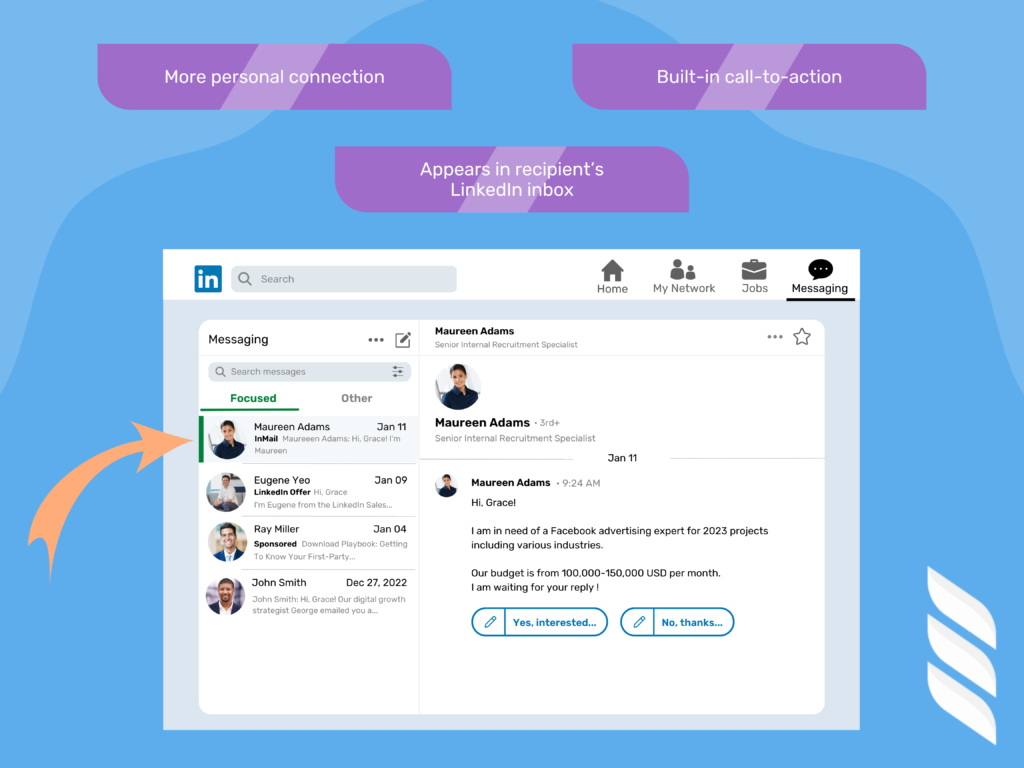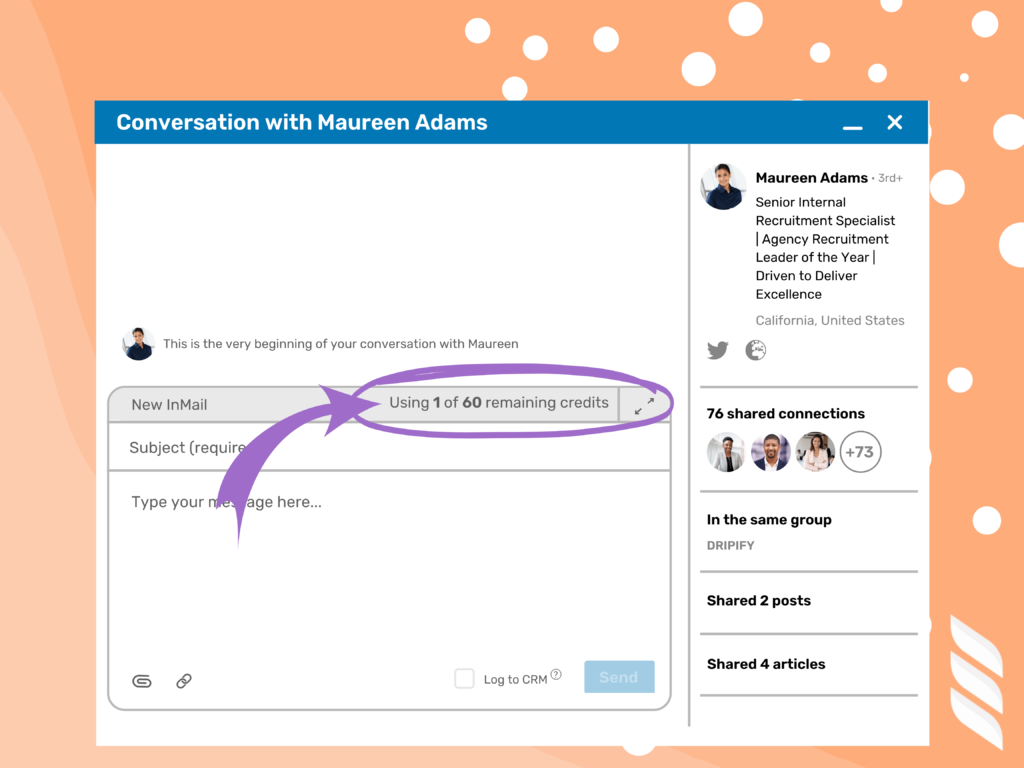|
Getting your Trinity Audio player ready...
|
Do you want to contact a potential employer, client, or networking prospect? If so, you might be wondering whether to use LinkedIn InMail or Email.
You may think email is better than LinkedIn InMail. After all, email is the standard way of communicating online. But did you know that LinkedIn InMail is a newer communication tool quickly gaining popularity in the professional world?
LinkedIn InMail allows you to send messages directly to someone’s inbox, which means they’ll see your message immediately.
So which is better: LinkedIn InMail or Email?
If you want a clear-cut answer to this question, we hear you. In this LinkedIn InMail vs. email guide, we’ll explore the pros and cons of each option to help you make the best decision for your communication needs.
Stick around a little longer to know which communication medium takes the cake – the answer may surprise you!
What Is LinkedIn InMail?

InMail is a messaging system that allows you to contact any LinkedIn member, even if you’re not connected. You only need a paid LinkedIn premium account and the person’s LinkedIn profile.
Besides allowing you to contact anyone on LinkedIn, InMail messages are more likely to be seen, read, and responded to. That’s because LinkedIn prioritizes InMails over other messages in members’ inboxes.

Here are three more reasons why you should start using LinkedIn InMail today:
1. LinkedIn InMail is Convenient
Finding time for networking can be difficult when you have a million other things on your plate. The good news is that with LinkedIn InMail, you can network without leaving your desk. Simply compose your message, hit send, and wait for a response.
2. LinkedIn InMail is Personalized
When you reach out to someone via LinkedIn InMail, you can stand out from the crowd and make an impression. That’s because, unlike other forms of communication, such as email or social media, InMails are highly personalized.
You can include the recipient’s name, picture, and even job title in your message so that they know you’re not just copying and pasting the same message to everyone.
3. LinkedIn InMails Are Trackable
With LinkedIn InMail messages, you can track when your message was viewed and whether or not the recipient clicked any of the links included in your message.
This valuable information can help you gauge whether or not your networking efforts are paying off and adjust your strategy accordingly.
InMail vs. Email


Imagine that you’re scrolling through your LinkedIn feed, and you see a post from a connection about how he just landed a new job. You click on his profile to see if he’s in similar groups as you are, and remember that he’s part of the same alumni group.
You decide to reach out to him and request an informational interview. If only there were an easy way to reach out to 2nd or 3rd-degree connections without going through all that hassle…wait, there is LinkedIn InMail.
Most professionals turn to LinkedIn for their outreach and networking campaigns because of its broad footprint.
But should you use InMail or email to communicate with your potential contacts and spread the word? If you cannot reach a decision, let’s do a detailed comparison to help you out.
InMail Pros
Here are three of the biggest benefits of using LinkedIn InMail:
1. You Can Connect with Hard-to-Reach Prospects
LinkedIn InMail allows you to contact anyone on LinkedIn, even if you are not connected to them. This means you can reach out to potential customers or employers who would otherwise be difficult to contact.
2. You Have a Higher Response Rate
LinkedIn InMail has a very high response rate compared to other methods of contact, such as email or phone calls. Also, since LinkedIn InMails are personal and relevant, they are also less likely to be ignored because they come from a trusted source.
Read also: B2B Cold Email Response Rate
3. You Can Stand Out from the Crowd
When you use LinkedIn InMail, you are guaranteed that your message will be seen by the person you are trying to reach.
LinkedIn InMails go straight to the person’s inbox, bypassing any spam filters that might be in place. What’s more, your message will stand out from the barrage of emails and phone calls that most people receive.
InMail Cons
Before you decide to use LinkedIn InMail for your business communication, let’s look at some of its cons:
1. You May Not Reach Your Ideal Customer
One of the biggest cons of LinkedIn InMail is that you may not be able to reach your ideal customer. Since only premium members can send InMails and most people with a premium membership are recruiters, you might not reach your ideal audience stratum.
So if you are trying to reach a decision-maker at a company, there is a probability that they will not see your message.
2. You May Come Across as Spammy
Another downside of LinkedIn InMail is that you may come across as spammy because LinkedIn InMail messages often look like sales pitches, and people tend to delete or ignore sales pitches.
If you want to avoid being spammy, ensure your InMail message is personal and relevant to the recipient.
Email Pros
You’re probably familiar with the standard process of connecting with someone on LinkedIn. You find a mutual connection, send a connection request, and wait for the person to accept. Once they do, you can start messaging them. Compare LinkedIn InMail vs connection request.
But what if there was an easier way to reach out to your dream contacts on LinkedIn? What if you could bypass the need for a mutual connection altogether? Enter LinkedIn outreach via email.
Here’s what makes email a viable medium for your LinkedIn goals:
1. You Can Send Personalized Messages
When you reach out to someone via email, you can personalize your message and explain why you’re reaching out. This is much harder to do with LinkedIn’s Inmail feature, which limits messages to 300 characters.
2. You Can Include Attachments
Sometimes, a simple message isn’t enough. Maybe you want to include a white paper or an e-book that interests the person you’re emailing. With LinkedIn Inmail, you can’t include attachments, but with email, you can.
3. You Can Respond Whenever Convenient
With email, there are no time limits. If you want to wait a few days (or even weeks) to respond to an email, that’s no problem. With LinkedIn Inmail, however, messages expire after seven days unless they’re responded to.
Email Cons
Here’re a few cons of email outreach:
1. You Might Not Reach the Right Person
Even if you’re optimistic that you know the name and company of your prospect, there’s no guarantee that you’ll reach the decision-maker with email communication.
It’s not uncommon for salespeople to spend hours crafting the perfect email only to have it go straight to someone’s spam folder.
2. Your Email Might Get Lost in the Noise
Sending an email is always going to be a bit of a gamble. You need to know whether or not your message will reach its intended recipient. And even if it does, there’s no telling how long it will take them to respond (if they respond at all).
Emails get lost in the shuffle, especially when someone is bombarded with dozens of messages daily. To increase your chances of getting a response, you may want to pick up the phone or send a regular LinkedIn message instead.


Which Channel is More Effective?
According to some estimates, the average person receives 100 to 120 emails per day. That’s a lot of emails to sort through — and it will only worsen over time.
So, when reaching out to potential customers or business contacts, which channel should you use: LinkedIn InMail vs. email?
LinkedIn InMail gets the upper hand in professional and marketing communications.
Benefits of LinkedIn InMail over Email


For one, LinkedIn InMail messages are less likely to get lost in the shuffle because they appear right in the recipient’s LinkedIn inbox. They also can’t be easily ignored the way an email can because they require the recipient to take action to dismiss them.
With LinkedIn InMails, you can include the recipient’s first name, last name, and even an image in your message, which helps create a more personal connection.
Plus, you can customize your message further by including information about how you’re connected to the recipient and why you’re reaching out.
Lastly, LinkedIn InMails has a built-in call-to-action (CTA) that encourages the recipient to take action on your message.
You can customize the CTA based on your specific goals, but some examples might include “schedule a meeting” or “learn more about our products.”
Email messages, on the other hand, typically don’t have CTAs, which means it’s up to the recipient to decide what action (if any) to take.
Drawbacks of LinkedIn InMail Over Email
Of course, no channel is perfect, and some drawbacks are associated with using LinkedIn InMail over email.
One such drawback is that LinkedIn InMails can be costly. Depending on your membership level, each message may cost anywhere from $0.99-$5.00.
Email, on the other hand, is free to send and receive. But despite this price drawback, we believe that overall, LinkedIn InMail is a more reliable channel than email for professional and marketing outreach.
LinkedIn InMail Best Practices
InMails can be tricky to use effectively; if you don’t use them thoughtfully, you risk coming across as spammy or pushy — not exactly the best foot to put forward when building relationships with potential clients or collaborators.
Here are LinkedIn InMail best practices to use to maximize your chances of getting a response (and building a meaningful connection):
1. Check if You Have InMail Credits First


Before you do anything else, make sure you have InMail credits.
LinkedIn members with paid subscriptions get a certain number of InMail credits per month, which allows them to send direct messages. If you don’t have any InMail credits, you won’t be able to send a message.
2. Personalize Each Message
Generic messages are less likely to get a response than customized messages. As such, it is a good idea to take some time to look at the person’s LinkedIn profile and see what projects they’re working on, what companies they’re interested in, and what groups they belong to — then mention those things in your message.
Let’s say you want to reach out to someone who works at Google and is interested in digital marketing. You could say, “I noticed you work at Google and are interested in digital marketing. I thought you might be interested in my blog post about how Google uses SEO.”
2. Keep it Short and Sweet
Long messages mostly get ignored, so make sure your message is short, sweet, and straight to the point. Getting right to the point also shows that you respect the person’s time, making them more likely to respond positively to your message.
3. Offer Value


Instead of asking for something from the person you’re reaching out to, try offering them something of value first.
This could be a resource, helpful advice or information, or even an introduction to someone in their network who can help them with whatever they’re working on.
Not only will this make the person more likely to respond positively to your message, but it will also lay the groundwork for future interactions and collaboration — win-win!
3. Follow Up…But Don’t Be Pushy
Once you’ve sent your initial message, it’s ok (and even encouraged) to follow up once or twice if you are still waiting to hear back. Just make sure not to come across as too pushy — otherwise, you’ll quickly turn off whoever you’re trying to connect with.
A good rule of thumb is to wait at least three days before following up the first time, then wait another 3-5 days before following up again (if necessary).




What Is the Difference Between an InMail and a Message on LinkedIn?
While regular messages on LinkedIn require that both parties be connected for the message to be sent, InMails bypasses that requirement. This means that you can reach anyone on LinkedIn, regardless of whether or not you have a connection.
Another key difference is that InMails allow you to include attachments. So, if you want to include additional information or resources along with your message, you can do so with an InMail. This feature is not available in a regular LinkedIn message.
Lastly, InMails offer greater customization options than regular messages. With an InMail, you can personalize the subject line and message body to ensure your message gets noticed and read by its intended recipient.
When Should You Use an InMail?
There are several situations where sending an InMail may be preferable to sending a regular message on LinkedIn.
For example, let’s say you want to connect with a decision-maker at a company you’re interested in doing business with. If you don’t have any connections at that company, your best bet would be to send an InMail rather than a regular message.
The same is true if you want to connect with someone who gets a lot of messages and might not see yours unless it’s flagged as a high priority.
Sending an InMail also allows you to attach additional files, as mentioned above. So, if your message requires additional information that can’t be conveyed in the body of the message itself, using an InMail will ensure that your recipient has all the information they need.
How to Get More InMail Credits on LinkedIn?
Essentially, InMail is like email but for LinkedIn members only. This feature can be incredibly useful, but it doesn’t come without limitations.
For starters, each user is allotted a limited number of InMails per month – typically between 10-15.
Once you’ve used up all of your monthly InMails, you either have to wait until the next month for more or buy more.
Here’s how you can get more InMail credits:
Complete Your Profile
The first step is ensuring that your profile is 100% complete. According to HubSpot, “a complete profile is 12 times more likely than an incomplete one to receive opportunities through InMail.”
Simply put, the more complete your profile is, the more likely people will want to InMail you with opportunities. So take the time to fill out every section on your profile, including your summary, portfolio, education, skills, volunteering experiences, etc.
If you have a Premium LinkedIn account, you can add rich media like videos, presentations, and articles to showcase your expertise and make your profile stand out.
Use Keywords Strategically
Now that your profile looks sharp, it’s time to consider keywords. Just like with SEO keyword strategy planning, you want to carefully select the phrases that potential employers or customers would use to search for someone with your skillset.
Once you’ve chosen 1-5 keywords or phrases, try incorporating them into different sections of your profile, like your headline, summary, work experience descriptions, etc.
But beware – stuffing keywords in too many places will make you look spammy. A good rule of thumb is to use keywords judiciously to appear natural. If it sounds forced, then it probably needs reworking.




Conclusion
There you have it: LinkedIn InMail vs. email – a comprehensive comparison of LinkedIn InMail and email for your business’s marketing endeavors.
In the modern world of business, it’s crucial to stay connected with your target audience. To do so, you need to find ways to make contact with potential customers and partners regularly.
Even if you have only just dipped your toes into the waters of networking, you’ve probably heard about LinkedIn InMail. To reach new audiences, many professionals opt for sending an InMail instead of emails, which is a great way to break through all that noise and stand out from the crowd.
But are these two methods of staying in touch with customers and partners really that different? To a greater extent, YES! Email has become a traditional form of communication compared with modern communication channels like LinkedIn.
LinkedIn InMail is a powerful tool that enables businesses of all sizes to reach out to prospects, introduce their brand, and develop relationships that can lead to conversions and customer loyalty. Using InMail, marketers can turn opportunities into tangible results in ways that weren’t possible before.
Make sure to use LinkedIn InMail thoughtfully and consistently to reach out to prospects who can benefit from your offerings, and you will soon find yourself reaping the rewards. It’s no longer a secret that LinkedIn InMail is worthy of a marketer’s attention.

![How to Write a Price Increase Letter [Tips, Examples, and Free Template]](https://dripify.io/wp-content/uploads/2021/12/27.png)
![How to Write an Effective Collaboration Email [+Templates]](https://dripify.io/wp-content/uploads/2023/05/13.png)



